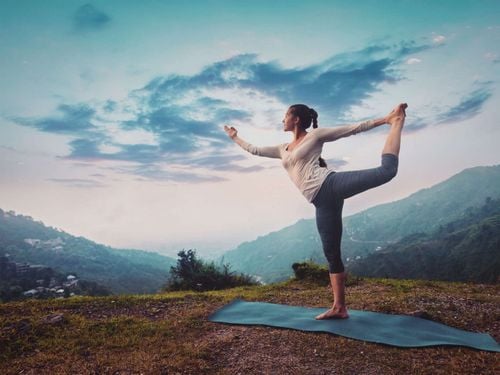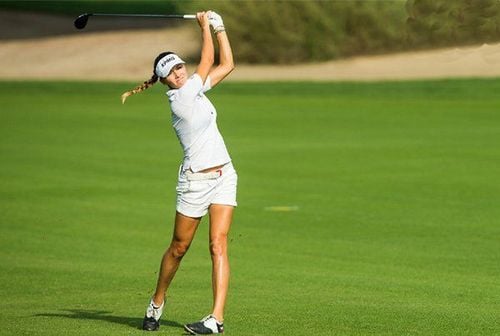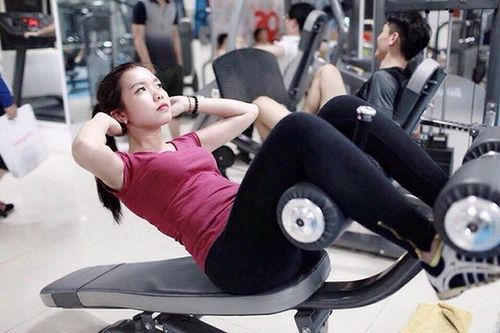This is an automatically translated article.
When you see a golfer maintaining good balance throughout his stroke, it looks solid, as if all moving body parts - legs, arms, arms and torso - are working harmoniously. tie, and the swing also looks graceful. The opposite of this is a swing that looks loose or as if the golfer is tense. This article will help you understand more about the benefits of balance when playing golf to help you have an easier swing.1. Benefits of balance while playing golf
Golfing is a great way for those who enjoy a low-impact exercise. It is a competitive, social sport that involves regularly walking around a playground. However, the repetitive swinging motion can cause pain and injury. This usually affects the arms and causes back pain, but it can involve any part of the body because golf swing is a full-body movement.Golfers are always striving for distance and accuracy on longer shots and precise control of shots approaching the green. Without good balance, we will not be able to make the most accurate and effective shots.
A well-balanced swing allows golfers to have better control of the club and send it straight into the ball, ensuring ultimate precision. Creating the clubhead speed needed to maximize power also requires good balance.
To lay the groundwork for a powerful swing with your shots, it all starts with the player's stance. Your heels should be slightly wider than your shoulders. Narrow stances often lead to imbalanced swings and off-target shots or worse, injury to golfers. When doing the backswing, shift your weight from the left to the right, but it's important not to let the weight slide beyond the right foot. Shifting body weight to the outside of the right foot is a major cause of right-side overeating, because on lowering the club the club falls behind the body and the clubface opens at impact.
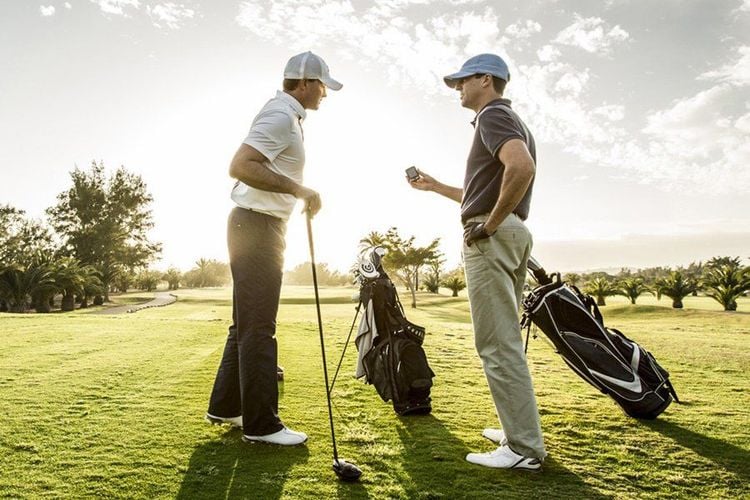
Thăng bằng khi chơi golf có vai trò quan trọng quyết định thành công của cú đánh
Golfers who continue to swing their arms after their shoulders have receded as far as possible cause their torsos to lean forward, which can easily lead to loss of balance. This reduces the likelihood of the club making correct contact with the ball. Even professional golfers can experience this problem and some - including Sergio Garcia and Davis Love III - have changed to more compact swings to improve accuracy without having to shorten the distance.
Many people may intentionally lift their left heel off the ground near the top of the backstroke in the hope of lengthening their stroke and creating more power. In his book, "Golf My Way," golf legend Jack Nicklaus warns against raising it too high, because it can cause the player's legs to drift off the starting point, causing loss of balance. even and makes shots lack the necessary precision, even though the power of the ball is very good. In a balance swing, the heel should only touch the ground when the shoulders bounce on the backswing. Regular footwork helps create a precise and safe swing.
Before starting the swing, Jack Nicklaus tilts his right knee slightly toward the target, which helps him keep his weight on the inside of his right foot as he executes a powerful backstroke. Jack is also always in a slightly bent knee position, which allows him to keep his balance throughout the shot.
2. How to keep balance when playing golf
Watching a professional golfer with a swing that demonstrates good balance is an intuitive experience. A series of flexible movements that do not take too much effort. Improving our balance also has practical benefits in life. Golfers who maintain good balance throughout the stroke can generate maximum clubhead speed and are more likely to hit the ball straight, firm, and precise.2.1. Step 1: Make sure a large enough training ground
Especially with large golf clubs, maintaining good balance requires starting with a large enough base. The guidebook "Lessons for Golf" advises that when swinging a golfer's heel should be outside - wider than - his shoulder. Too narrow a stance tends to throw golfers off balance, resulting in the clubface not returning to the proper square at impact and resulting in a lack of accuracy.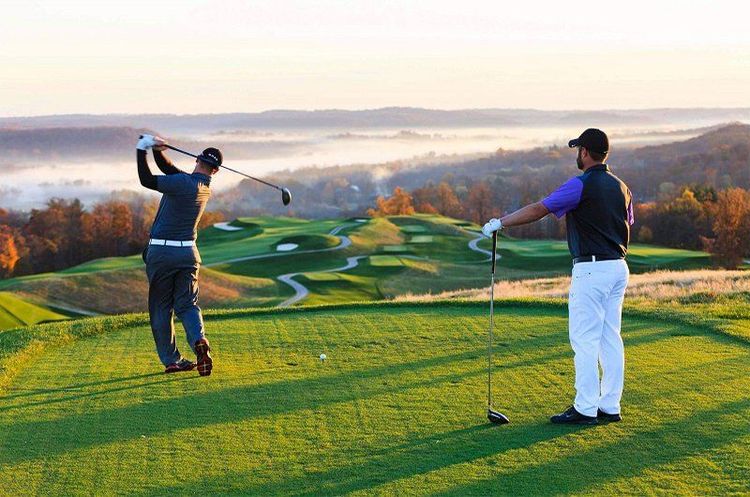
Thăng bằng khi chơi golf có thể tạo ra tốc độ đầu gậy tối đa
2.2. Step 2: The stance of the swing
Keep your weight on the inside of your right foot while hitting the ball back (for right-handed golfers). If their weight is off the right foot, golfers may shift their bottom too far toward the target in the downswing. Club motion will lag behind foot movement and we'll hit the ball when the clubface is open. To immobilize his right knee while swinging, golf legend Jack Nicklaus tilts his knee slightly before the start of the swing and keeps the knee flexible as he completes the backswing (aka backswing). ).2.3. Step 3: Maximize the swing arc
Maximize the arc while not overdoing it. To create power, golfers always want to rotate their shoulders as much as possible, but amateur golfers often lose their balance trying to achieve this goal.Your left heel should not protrude more than 1.5 cm from the ground when you reach the top of the backstroke. The author of "Private Lessons" advises that when your shoulders rotate as much as they can, that should be the top of the swing. Don't bend your left arm when trying to lengthen the shot - or strain to swing back so much that you move your head or let your torso lean toward the target.
2.4. Step 4: Achieve balance
Achieve balanced tracking. The "Golf Handbook" recommends that after completing your track, your body weight should be balanced on your left heel and on your right toe.3. 9 stretching exercises to help keep balance when playing golf
For balance and a better golf swing, practice stretching your extremities. These muscles help move your knee, helping to better rotate your body.Quadriceps stretch:
You will need a bench to do this move. Start with your back facing the bench, feet hip-width apart.
Place your hands on your hips or clasp your hands in front of your chest Bend your right knee. Place the top of your right foot on the bench. Engage your right gluteal muscles. Bend left knee, taking care to align it over left ankle Straighten left leg, return to standing position. Repeat 2 to 5 times on each side. Golf stretches your back
Golfers often strain their lumbar muscles. This stretch will help loosen tension in the area. You will also need a bench to do this move.
Forward folding with a chair Start facing the back of the bench, feet shoulder width apart. Hold the back of the chair and take a step back until your arms are extended. Lower your upper body, keeping your back straight. Continue until you feel a stretch in your armpits. Hold for 30 seconds. Repeat 2 to 5 times on each side. Golf for your hips
If you have tight hips, it may be difficult for you to squat while golfing. It also limits how much you can rotate your body. To open up your hips, try the following:
Sitting Hip Stretch This stretch helps relieve tension in your hips, thighs, and back. Sit with your back straight on a bench, chair, or floor. Place your left ankle on top of your right thigh. Place your right foot on the ground. Move your torso forward, bending at your waist. Continue until you feel a stretch in your left hip. Hold for 30 seconds. Repeat 2 to 5 times on each side. Kneeling hip extension
If you can comfortably kneel on the ground, try this move. It is great for stretching your hips, buttocks and thighs.
Begin to bend your knees, straighten your back. Place your right foot on the ground, just below your right knee. Place both knees at a 90-degree angle. Place your hand on your right thigh. Pull your shoulders away from your ears. Slowly move your right leg forward, keeping your ankle below your knee, and lean forward until you feel a stretch in your left hip flexor. Hold for 30 seconds. Repeat 2 to 5 times on each side. Golfing your elbow
Repetitive motion while playing golf can lead to golfer's elbow. In this condition, the muscles in your elbow and forearm become inflamed, causing pain and tenderness. The following exercise can help you feel relieved. It stretches the muscles in your forearm, relieving tension in the elbows and arms.
Golfer's Elbow Stretch Extend your right arm in front of you. Palm down. Use your left hand to pull your right fingers down and toward your body. Hold for 30 seconds. Bring the palm back to the original position. Pull your wrists up and toward your body. Hold for 30 seconds. This completes a representation. Repeat 2 to 5 times on each side. You can also try this move with your palms facing up.
Stretch your wrists
The above exercise feels great on the wrist. But you can also do a prayer move to lengthen your wrist even more. This move can help reduce carpal tunnel syndrome caused by constant gripping.
Press your palms together. Place them in front of your chest. Bring your hands to your waist, keeping your palms together. Hold for 30 seconds. Repeat 2 to 5 times. Stretches for your core muscles
A flexible golf swing relies on strong and flexible core muscles. This stretch stretches these muscles so that you can rotate easily. It mimics a backflip and follows.
Core Torsion Stand up straight, feet shoulder width apart. Cross your arms in front of your chest. Bend your knees and lean your upper body slightly forward. Rotate your torso to mimic your backstroke. Pause. Rotate your body to mimic your tracking action. Hold for 30 seconds. Repeat 2 to 5 times.
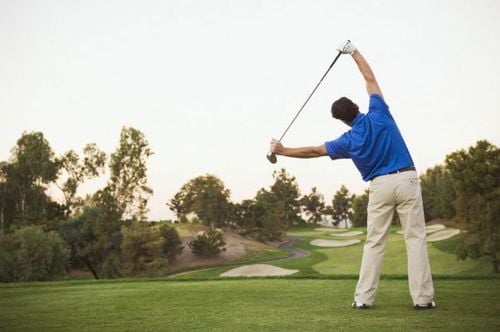
Các bài tập kéo căng giúp giữ thăng bằng khi chơi golf
Your hamstring muscles are located on the back of your thighs. They allow for knee rotation and thigh extension, allowing you to rotate while golfing. To loosen them, do this move. You will need a golf club and a walker.
Golf Club Tendon Place your club behind your shoulder, holding one end in each hand. Stand one step ahead. Place your right heel on top of the step, knee slightly bent. Lean forward at hip level, back straight. Rotate your upper body to the right. Hold for 30 seconds. Repeat with the left side. This completes a representation. Switch legs and repeat. Repeat 2 to 5 times. Stretch your shoulders
Golf is hard on the shoulders too. Try this exercise to manage shoulder pain.
Shoulder rotations Start with your feet shoulder-width apart. Raise your right arm to chest level, placing the opposite hand on your right elbow. Move your right wrist towards the left thumb, pointing the thumb up. Rotate your torso to the left. Pull your right elbow. Hold for 30 seconds. Hold your left elbow with your right hand. Rotate your torso to the right and hold for 30 seconds. Repeat 2 to 5 times. Golf is a great sport for those who want to do light exercise. This is a highly competitive, social sport. However, to make a swing with correct posture is not easy and the ability to keep balance is the leading factor determining the accuracy of the shots. In addition, good balance also helps golfers avoid injuries encountered during swinging.
Please follow the website ( www.vinmec.com ) for more information on health care instructions, which we will update regularly.
Please dial HOTLINE for more information or register for an appointment HERE. Download MyVinmec app to make appointments faster and to manage your bookings easily.
References: mayoclinic.org, healthline.com, golftips.golfweek.usatoday.com




